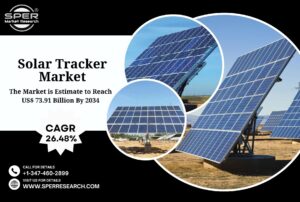Solar Tracker Market Trends and Future Investment 2034
A Solar Tracker is a sophisticated mechanical and electronic system that constantly aligns photovoltaic panels or concentrated solar devices with the sun throughout the day in order to maximize energy capture. Solar trackers actively modify their location in response to the sun’s trajectory, optimizing sunlight incidence and increasing energy generating efficiency. Trackers are divided into two types: single-axis systems, which rotate panels along a horizontal or vertical axis, and dual-axis systems, which allow movement along both axes to precisely line with the sun. To improve performance, defend against extreme circumstances, and reduce operational losses, modern trackers frequently use smart sensors, AI-driven controls, and weather-adaptive mechanisms. Solar trackers are important in cost-effective and sustainable solar power generation.
According to SPER Market Research, ‘Global Solar Tracker Market Size- By Product, By Technology, By Application – Regional Outlook, Competitive Strategies and Segment Forecast to 2034’ states that the Global Solar Tracker Market is predicted to reach 73.91 billion by 2034 with a CAGR of 26.48%.
DRIVERS:
The Global Solar Tracker Market is quickly developing due to several significant growth drivers. The growing emphasis on clean energy transition and strict emission reduction objectives is pressuring governments and developers to embrace more efficient solar systems. Solar trackers are becoming increasingly popular in utility-scale projects because they boost power generation by aligning panels with the sun’s path, yielding higher returns than fixed-tilt systems. The ongoing drop in solar module costs makes the additional investment in trackers more cost-effective, while design enhancements and smart features such as weather sensors, remote monitoring, and AI-based controls improve dependability and lower operational costs. Furthermore, advantageous government subsidies, renewable energy standards, and the necessity for optimal land management all contribute to their broad acceptance, establishing solar trackers market.
Download the Detailed Analysis in PDF format, Here
RESTRAINTS:
Despite increased popularity, the Global Solar Tracker Market faces many barriers to expansion. High initial capital expenditures remain a significant hurdle, particularly for small-scale developers and regions with little financing choices. Installation complexity, including exact alignment and technical requirements, lengthens project schedules and necessitates trained labor, which may be scarce in emerging areas. Trackers are particularly susceptible to adverse climatic conditions such as high winds, snow, dust, and extreme temperatures, which can cause mechanical wear, increased maintenance costs, and probable downtime. Uneven or sloped terrain may limit deployment without specialist designs, increasing civil and structural expenditures. Additionally, volatility in steel and raw material pricing, supply chain disruptions, and reliance on government subsidies all contribute to financial and operational uncertainty.
North America, particularly the U.S., dominates the Global Solar Tracker Market due to large-scale utility solar projects, supportive government incentives, and advanced technological adoption. Some of the leading companies are All Earth Renewables, ArcelorMittal, Arctech, Array Technologies, Convert Italia, Degerenergie, GameChange Solar, Gonvarri Solar Steel, Nextracker, Scorpius Trackers and Others.
For More Information, refer to below link: –
Related Reports:
Europe Solar Panel Recycling Market Size
United Kingdom Solar Charger Market Size
Follow Us –
LinkedIn | Instagram | Facebook | Twitter
Contact Us:
Sara Lopes, Business Consultant — USA
SPER Market Research
enquiries@sperresearch.com
+1–347–460–2899





